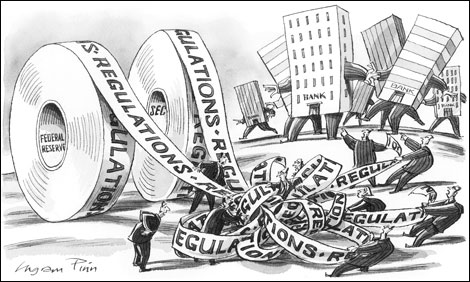The year of 2012 saw one of the biggest scandals in the international banking industry that went unnoticed and was less talked about amidst the Euro Zone crisis. The reason this becomes big now and needs immediate attention is because it could be the beginning of a ‘Big Bank Scandal’. When banks start operating purely for profit purposes, then any sort of manipulation may yield to serious results where the customers face huge losses and a loss of investors’ confidence. Before digging deep in the scandal, it is important to know exactly what Libor is and how it is controlled.
Libor is London Inter-bank Offered Rate which is set as an average value (stripped of the highest and lowest rates) of the rates at which banks are prepared to lend to each other. If a balance sheet of a bank has a mismatch, they are usually reckoned by borrowing from (in the scarcity of cash) or lending to (in excess of cash) other banks. In such cases, Libor measures the cost of this inter-bank lending setting out the average rate banks pay to borrow from one another. It has a wide impact involving key currency rates, business loans,mortgages and even student loans

Libor is checked by British Bankers Association (BBA) and lately, it lost its role and responsibility to the UK bank regulator, the Financial Services Authority (FSA). As described by BBA Libor ‘acts as a barometer of how global markets are reacting to the prevailing conditions’. Complex derivative products used by professional traders in the bond and currency markets are commonly priced using Libor. During US Sub-prime Mortgage Crisis, Libor soared up because of the loss of investor’s confidence in the international banking industry. Libor influences $800 trillion worth of transactions[1] and hence also becomes a grave concern if any manipulation is done with the rigging of rates.
THE BARCLAYS STORY
June 2012 witnessed that Barclays bank (and others) had been manipulating the dollar Libor and Euribor (Euro zone’s equivalent to Libor) to boost its financial position or to benefit its traders. The affair saw that Barclays was fined a record £290 million by authorities in the UK and the USA.However, this rate rigging had been evident since 2005 where Barclays played with its rates on the request of its derivative traders and other banks. According to FSA report, 257 such requests had been made to Barclays by external traders between 2005 and 2009.
This rigging involved traders from Tokyo, New York, and London. These years saw many reports submitted by FSA stating that the Libor was unrealistically low. In September 2009, following the collapse of Lehman Brothers, the Bank of England had a conversation with a senior Barclays official, in which the Bank of England raised questions about Barclays’ liquidity position and its relatively unrealistic Libor submissions. In late 2011, Royal Bank of Scotland sacked four people for Libor-fixing.However, something that started as early as 2005, turned really big by June 27, 2012, leading to Barclays admitting to its misconduct. The UK’s FSA imposed a £59.5m penalty. The US Department of Justice and the Commodity Futures Trading Commission (CFTC) imposed fines worth £102m and £128m respectively, forcing Barclays to pay a total of around £290m. This led to a fall in Barclays credit rating from stable to negative by Moody’s. On July 17, 2012, US Federal Reserve Chairman Ben Bernanke told a Senate committee that the Libor system was “structurally flawed” said that he still did not have full confidence in the system. On 16 August 2012, it was announced that seven banks including Barclays, HSBC and RBS are to face legal questioning in the US. The other banks to receive the subpoenas from the attorney generals of New York and Connecticut were Citigroup, Deutsche Bank, JP Morgan and UBS.
Barclays might have been forced to lower its own borrowing cost to the BBA in 2008 because almost ever another bank was also doing so at that time. Such financial panic could have led to Barclays being nationalized like Royal Bank of Scotland (RBS). It is said that Bank of England had this knowledge since long but chose to remove Mr. Diamond, Barclays chief executive by the end of this year. The sad part of this scandal was that many banks involved, sailed through under the eye of UK and US financial regulators during what could turn out to be ‘one of the- world’s biggest bank scandal’ and that too during the world economic turmoil .
On 28 September 2012, the FSA confirmed that the BBA would no longer administer Libor, and would be replaced by a data provider (like Bloomberg or Reuters) or a regulated exchange. The report stated that the Libor system was broken and required a complete overhaul, including criminal prosecutions for those who try to manipulate it. The regulator also suggested basing Libor calculations on actual rates being used, rather than estimates currently provided by banks.On 19, December 2012, Swiss bank UBS was fined a total of $1.5bn (£940m) by US, UK, and Swiss regulators for attempting to manipulate Libor. It agreed to pay $1.2bn in combined fines to the US Department of Justice and the Commodities Futures Trading Commission, £160m to the UK’s Financial Services Authority, and 59m Swiss Francs to the Swiss Financial Market Supervisory Authority.
Barclays and UBS are just some of the banks that have manipulated the Libor and admitted to this scandal. The banks in this scandal are not only big UK banks but could also be big American, Canadian, Japanese or European banks. This is definitely just a beginning of something that could lead to one of the biggest financial crisis in the international banking industry not only relating to Libor but many ‘yet to be exposed bank regulation scandals’.
© 2012 Deena Zaidi. All rights reserved.
[1] http://www.dailyforex.com/forex-fundamental-analysis/2012/09/Libor-Fallout-May-End-Practice/14762



Leave a Reply